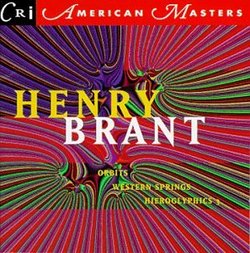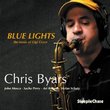| All Artists: Henry Brant, Jacob Glick, La Jolla Symphony, La Jolla Chorus Title: Orbits / Heiroglyphics / Western Springs Members Wishing: 0 Total Copies: 0 Label: Composers Recordings Release Date: 7/20/1999 Album Type: Import Genres: Pop, Classical Styles: Vocal Pop, Opera & Classical Vocal, Chamber Music, Historical Periods, Classical (c.1770-1830), Modern, 20th, & 21st Century, Symphonies Number of Discs: 1 SwapaCD Credits: 1 UPC: 090438082723 |
Search - Henry Brant, Jacob Glick, La Jolla Symphony :: Orbits / Heiroglyphics / Western Springs
 | Henry Brant, Jacob Glick, La Jolla Symphony Orbits / Heiroglyphics / Western Springs Genres: Pop, Classical
|
Larger Image |
CD DetailsSimilar CDs
|
CD ReviewsMaybe not the best Brant disc you can find, but now a desira Discophage | France | 05/09/2008 (4 out of 5 stars) "Henry Brant is well known (at least in the textbooks) as one of the main 20th Century proponents of "spatial" music, with orchestras, choruses or instrumental groups widely disseminated in the concert venues. But among the hallmarks of his uniquely imaginative sonic invention, there is also a taste for what I would call "mono-timbral" ensembles. New World records have published a disc gathering such works written for various flute ensembles throughout Brant's life, starting with the seminal "Angels and Devils" from 1931 (Henry Brant: Music for Massed Flutes). But Orbits for 80 trombones (1979) is one of the most famous and oft-mentioned of such pieces. Composition for homogeneous timbre of course does not exclude spatial dissemination. Orbits was created at St Mary's Cathedral in San Francisco and according to a long quote from Time Magazine reproduced in the liner notes, the 80 trombones were ranged in front of the audience in a huge semicircle.
To be entirely honest, Brant cheats: he adds an organ, and its copper-hued timbre is not so dissimilar with those of the trombones. As for the latter, they build a gamut of over five octaves, from contrabass to soprano, and play at times in eighty real parts. In fact, the homogeneity of timbre, with its consequent potential risk of blandness, is not what jumped to my ears, so deftly does Brant use the full resources of his giant keyboard - or should I say slideboard. I am sure that aspect would be more impressive live. But what is really impressive on this recording is the remarkable quality of Brant's music language: it is fully contemporary, very characteristic of the most advanced from the late 1960s and 1970s, that is to say: raw, brutal, even angry, playing on mass and color rather than melody. Penderecki before he turned conservative and became a derivative neo-Bruckner may come to mind. The organ part sounds like the kind of stuff Gerd Zacher might have played (those familiar with contemporary music from the 1970s will know what I mean, I think). Hieroglyphics 3 was composed in 1958 and is one of the rare "early" pieces of Brant available on CD - most of what has been published by the highly valuable Innova Brant collection dates from the mid-seventies onwards. It was revised in 1970 and this is what is heard here. It is a kind of chamber concerto for Viola accompanied by timbani, chimes, vibraphone (celesta in the original version), piano, harpsichord (originally harp), improvising voice and improvising pipe organ (the two latter being additions from 1970). The viola soloist is supposed to play from three widely separated positions in a dark hall. On the recording he is confined to the left channel (with the mezzo soloist), while the accompanying ensemble is situated at the right. The sonic perspective seems somewhat artificial and, partly because of that, it sounds like a mixture of electronic/tape music (the voice and the mostly crystalline sonorities of the accompanying ensemble) and of half-improvisatory music (even the fully notated viola part). It is somewhat austere and much smacking, I find, of the fifties and its early experiments on electronic music. Brant's oeuvre from the 1980s decade is now actually quite well represented on CD, especially on the Innova Brant collection, and Western Springs (1984) is one of those pieces, very typical of the special "spatial" composer, as hinted by its subtitle "A Spatial Assembly for 2 Orchestras, 2 Choruses and 2 Jazz Combos" spread apart in the venue and its over 200 performers. The work's "binary" nature is perfectly suited to disc. When Brant uses more ensembles, it doesn't register so well on stereo. Here, the left-right channel separation is ideal. As is Brant's custom, the texts are very factual descriptions of hot prings and geysers in five Western states (texts not provided unfortunately), and the choruses are very declamatory (as in Autumn Hurricanes from 1986 or The Henry Brant Collection, Vol. 6: Rainforest from 1989), bringing to mind the kind of vocal writing Milhaud used in his early pieces (Les Choéphores for instance), sometimes even sounding something like a congregation (2:45). The orchestral language is fully contemporary - again the music of Lutoslawski and radical Penderecki come to mind, as well as Ligeti's in the atmospheric passage at 16:40 -, with moments of quasi free-Jazz and some others that are surprisingly lyrical (at 6:47 for instance) - surprising given the music's grounding in a compositional style prevalent in the 1970s, but not surprising when you know Brant: his compositions are full of such beautiful moments. And do I hear, at 30:00, a short quote of Mahler - I haven't researched, but I think it is the finale of the 9th? All that being said, I'll confess to not being as taken by Western Springs as by other Brant compositions of the same ilk: too much chorus declamation maybe, and some moments in which I felt the music material was a little too milked and drawn out for what it had to offer. With the demise of CRI this disc has become difficult to find - at reasonable prices, I mean. I scouted quite a while and jumped when a seller lowered his price on the present website.True, New World has maintained it in the form of a CD-R reproduction, but I've had bad experiences with some of these NW reissues recently: my Sony MP-3 Discman goes berserk playing them, and since Discmans have now, in our era of Ipods, become rare commodities, I exercice punctilious caution. Anyway, though I don't think this is the most interesting Brant CD you can find, its sheer rarity value makes it a highly desirable item for the Brant collector. " |

 Track Listings (3) - Disc #1
Track Listings (3) - Disc #1
